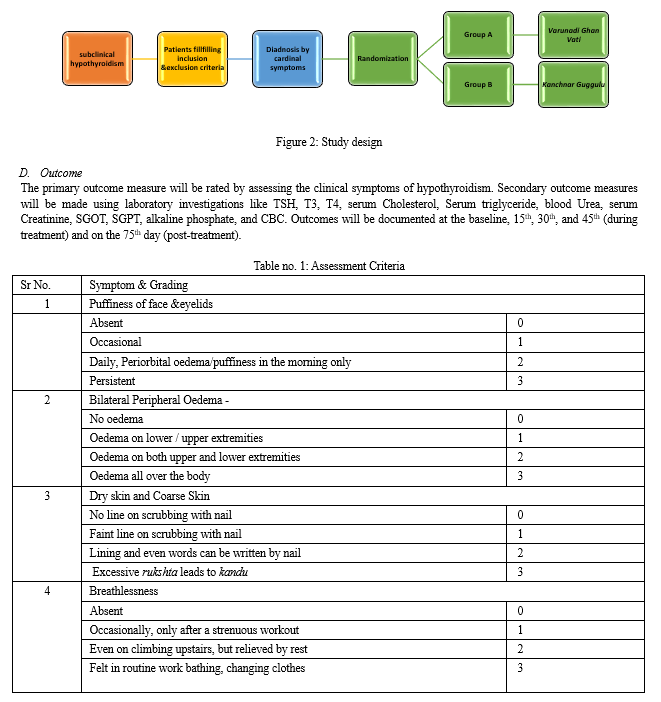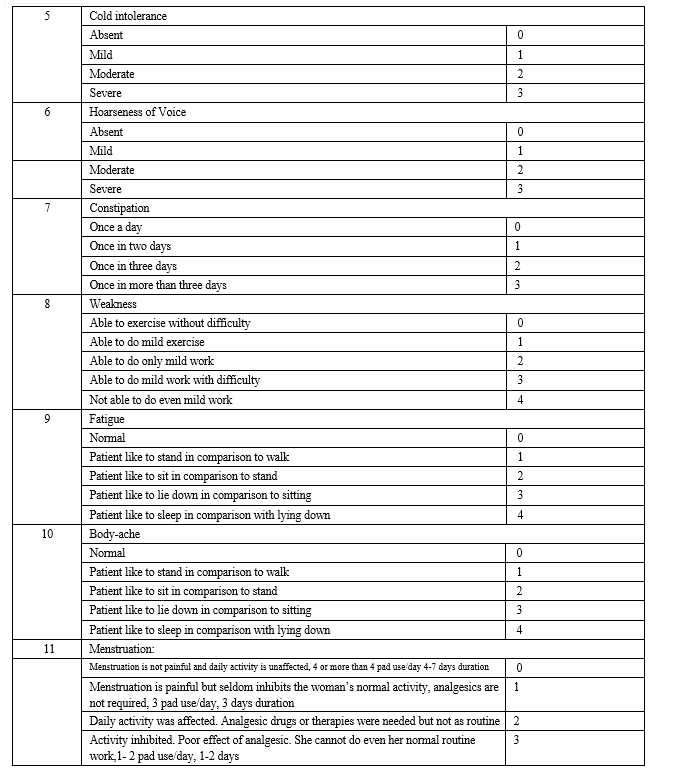Ijraset Journal For Research in Applied Science and Engineering Technology
- Home / Ijraset
- On This Page
- Abstract
- Introduction
- References
- Copyright
Comparative Effectiveness of Varunadi Ghan Vati and Kanchnar Guggulu in Management of Subclinical Hypothyroidism- Study Protocol for a Randomized Controlled Trial
Authors: Dr. Himanshi Jangra, Dr. Neha Lamba, Dr. Neelam Kumari, Dr. Piyush Chaudhary
DOI Link: https://doi.org/10.22214/ijraset.2024.59875
Certificate: View Certificate
Abstract
Background: Hypothyroidism is an emerging disease nowadays. India has a high prevalence of Hypothyroidism, which is about 10%. Hormone replacement therapy is advised in the treatment of hypothyroidism. However, in subclinical hypothyroidism, no treatment is advised. Ayurveda describes a number of treatment modalities for the treatment of disease on the basis of their dosha-dushya. The aim of this study is to evaluate the effectiveness of Varunadi Ghan Vati in comparison with Kanchnar Guggulu in the management of subclinical hypothyroidism. Methods and Design: This study will be a prospective, single-centered, randomized controlled trial. A total of 60 patients of age between 19 and 60 years, diagnosed with subclinical hypothyroidism, and presented with cardinal features of the disease will be randomized into two groups. In Group A, patients will be given Varunadi Ghan Vati and in Group B patients will be given Kanchnar Guggulu. Pathya-Apathya regarding the disease will be guided to both groups. Both groups will receive treatment for 45 days. Outcomes will be evaluated on the 15th, 30th and 45th days (during treatment) and 75th day(post-treatment). The primary outcome will be evaluated on the basis of cardinal symptoms of subclinical hypothyroidism. Improvement in laboratory investigations will be evaluated for secondary outcomes. Conclusion: This trial is the first to compare the effectiveness of Varunadi Ghan Vati with Kanchnar Guggulu in the management of subclinical hypothyroidism. Varunadi Ghan Vati is expected to improve the symptoms of subclinical hypothyroidism, thus proving to be effective in the management of patients with subclinical hypothyroidism. Trial registration: CTRI/2023/07/055295.
Introduction
I. BACKGROUND
In the modern era, the sedentary lifestyle, physical inactivity, and unhealthy food habits give rise to many metabolic disorders like obesity, type 2 diabetes, hypertension, hypothyroidism etc. Hypothyroidism is a disorder occurring due to hyperfunctioning of the thyroid gland. The subclinical form of hypothyroidism is the phase of compensation when TSH levels are raised than normal while T3 and T4 are within normal range in the blood.[1] Subclinical hypothyroidism is either asymptomatic or present with symptoms like puffiness of face and eyelids, bilateral periorbital oedema, dry skin and coarse skin, breathlessness, cold intolerance, hoarseness of voice, constipation, weight gain, fatigue, body ache, hair fall along with impaired menstrual cycle. [2] The prevalence of hypothyroidism is about 4-5%.[3] and subclinical hypothyroidism is about 4-15%.[4] India has a high prevalence of hypothyroidism, which is about 10%. It is much more common in females than in males.[5] Though there is no direct description of this disease in Ayurvedic text, there is a description in Ashtanga Hridyam that if the Vaidya does not know the disease name, he can treat the disease according to its prakriti, adhisthan, bheda and hetu.[6] According to Ayurveda, the metabolic processes of the body are under the control of Jatharagni, Bhutagni, Dhatvagni and Doshas.
The symptoms of subclinical hypothyroidism are developed due to alteration of metabolic activity; which according to Ayurveda, can be hypothesized- vitiation of mainly Kapha Dosha, Ras Dhatvagni and vitiated Vata due to Margavarodha by Kapha.[7]

Vitiation of Rasa Dhatu and Kapha doshas along with vitiation of Vata dosha can produce symptoms of subclinical hypothyroidism. The clinical picture of the disease shows the dominance of Kapha Dosha. The majority of the Nanatmaja Roga of Kapha Dosha[8] such as Alasya (laziness/lethargy), nindra-adhikya (hypersomnia), Tandra (drowsiness), apakti (indigestion), galganda (goitre), gurugatrata (body heaviness), balasak (asthenia), shwetabhasta (pallor), sheetagnita (impaired digestion), etc. can be included as a signs and symptoms of subclinical Hypothyroidism. Also, Dushti of Rasadhatu plays a major role in pathogenesis. Many of Rasaja Vikaras which have been mentioned in Ayurvedic text[9] are similar to the clinical features of subclinical hypothyroidism such as Gaurav (heaviness), tandra (drowsiness/lassitude), pandutavam (pallor), klabya (impotence), agninasha (loss of digestive power), sada (exhaustion or tiredness of body), ashradha (disinclination of food).
So, Hypothyroidism can be considered as anukta vikara and discussed under kapha dushti and ras dhatwagnimandya jnaya disorder by comparing its signs and symptoms to ayurvedic terminologies.
II. METHODOLOGY
A. Patients
Patients fulfilling the following criteria shall be included: Diagnosed cases of subclinical hypothyroidism with TSH ranging from 5.5 uIU/ml- to 15.0 uIU/ml. Patients with clinical features of subclinical hypothyroidism, irrespective of sex, religion, profession, etc. Patients with an age limit of 19-60 years. Patients of subclinical hypothyroidism are willing to take ayurvedic medicine and sign the consent form.
Patients shall be excluded for the following criteria: Patients aged below 19 years and over 60 years. Patients suffering from congenital hypothyroidism, overt hypothyroidism, and secondary hypothyroidism. Patients with hyperthyroidism, neoplasia, toxic goitre, and who have undergone any type of thyroid surgery. Patients taking a known drug to alter thyroid hormone level (e.g., Amiodarone). Pregnant ladies and lactating mothers. Patients having any other major complicated diseases like Cardiac disease, Diabetes Mellitus, renal failure, malignant disease, thyrotoxicosis & other systemic disorders. The patient is not willing to take the trial.
This study has been approved by the Institutional Ethical Committee with no. (SKAU/Acad/2022/6746) on dated 2nd November 2022 and is conducted according to the common guidelines for clinical trials. The trial registration number is CTRI/2023/07/055295. Informed consent will be signed by all the patients.
Procurement of the drug has been done from a reliable pharmaceutical providing quality contro report of the drug.
B. Randomization
Patients will be randomly assigned to interventional and control groups in a 1:1 ratio through a computer-generated randomization sequence. A patient will only be registered once and randomized once.
C. Study Design
In this single-blind, single-centered, randomized clinical trial all patients will be diagnosed on the basis of symptoms of hypothyroidism and TSH, T3, and T4 levels before randomization. After that Interventional group will receive Varunadi Ghan Vati in 500mg BD dose after the meal and the control group will receive a 1500 mg BD dose of Kanchnar Guggulu after the meal.




III. DISCUSSION
This trial compares for the first time the effectiveness of Varunadi Ghan Vati with Kanchnar Guggulu in the management of subclinical hypothyroidism. Hypothyroidism is an emerging lifestyle disorder nowadays. India has a high prevalence of Hypothyroidism, which is about 10%. It is much more common in females than in males.[5] Modern science is very well developed with advanced disease, diagnosis, and treatment techniques. Still only hormone replacement therapy for the control of endocrinal disorders such as subclinical hypothyroidism. It is lifelong therapy or no treatment given for subclinical hypothyroidism. Many studies show very little or no improvement in cognition, weight or quality of life in patients taking Levothyroxine for the milder form of subclinical hypothyroidism. [10-11] In patients with Subclinical Hypothyroidism, 2.6% each year if Thyroperoxidase (TPO) antibodies are absent and 4.3% if they are present convert into clinical hypothyroidism every year [12] Levothyroxine therapy has many side effects on the body. As Ayurveda emphasizes the treatment of preconditions (sanchya, prakopa, prasar, purvarupa), so that, the disease (vyadhi utpatti) does not progress to further stages. So, this study has been selected. According to Ayurveda, subclinical hypothyroidism can be considered as Anukta vikara and discussed as Kapha dushti, dhatwagnimandya janya vhadhi. In Hypothyroidism, the principal concern is to normalize the Kapha dosha and restoration of Agni. Varunadi Gana in shushrut Samhita is described as Kapha doshahar. Most of the drugs of Varunadi Gana are of teekshan, ushana guna such as chitrak[13] varun[14] are mentioned as agnivardhak. Bilva [15] is also given as Kapha vatahar, Agni deepan. Kanchnar Guggulu is a proven drug for subclinical hypothyroidism by previous research works [16]. Dosha dushya sammurchana causes vyadhi utpati. Kanchnar guggulu is in gandmala rogadhikar also given for agnideepan in Ayurvedic text.[17] Hence, Varunadi Ghan Vati and Kanchnar Guggulu were selected for the study. Here, an effort is undertaken to determine which remedy for subclinical hypothyroidism, Varunadi ghan vati or Kanchnar Guggulu, is more efficient. The paper outlines the methodology for a clinical trial to evaluate the effectiveness of Ayurvedic treatments for subclinical hypothyroidism. In conclusion, the paper offers valuable insights into the Ayurvedic perspective on subclinical hypothyroidism and proposes a clinical trial to investigate the efficacy of Ayurvedic treatments in managing this condition. This research has the potential to bridge the gap between traditional Ayurvedic approaches, providing treatment options for patients with subclinical hypothyroidism. However, the outcomes of the clinical trial will be essential in determining the practical applicability and effectiveness of these Ayurvedic interventions in the management of subclinical hypothyroidism.
A. Trial Status
This study is recruiting patients.
B. Declaration
- Ethics approval and consent to the participation: This study has been approved by the institutional ethics committee with no. (SKAU/Acad/2022/6746)
- Financial Implications: The financial allotment shall be given by Shri Krishna Ayush University for the study will be utilized and the trial will be completed within the financial limit provided by the institute.
- Followed Guidelines: The trial is conducted according to the common guidelines of clinical trials (Declaration of Helsinki).
References
[1] Jameson JL, Fauci AS, Kasper DL, Hauser SL, Longo DL, Loscalzo J, editors. Harrison\'s principles of internal medicine. 20th ed. New York: McGraw Hill Education; 2018. p. 2699. [2] Mujhal YP. Api text book of medicine, 9th ed. Mumbai: The Association of Physicians of India; 2015. p. 601-3. [3] Hollowell JG, Staehling NW, Flanders WD, Hannon WH, Gunter EW, Spencer CA, et al. Serum TSH, T (4), and thyroid antibodies in the United States population (1988 to 1994): National Health and Nutrition Examination Survey (NHANES III) J Clin Endocrinol Metabolism, 2002; 87: 489–99. [4] Bemben DA, Hamm RM, Morgan L, Winn P, Davis A, Barton E. Thyroid disease in the elderly. Part 2: Predictability of subclinical hypothyroidism. J Fam Pract, 1994; 38:583–8 [5] Unnikrishnan AG, Kalra S, Sahay RK, Bantwal G, John M, Tewari Neeraj. Prevalence of hypothyroidism in adults: An epidemiological study in eight cities of India. Indian J Endocrinol Metabolism, 2013 Jul-Aug; 17(4): 647–52. [6] Gupt A. Astanga hridyam: vidyotini hindi commentary. reprint ed. Varanasi: Chaukhambha Bharti Academy; 2019. Sutra sthana Chapter 12, Doshbhediyaadhyaya; versus 64-6. [7] Shastri R, Shastri K, Chaturvedi G. Charaka samhita: elaboratrd vidyotini hindi commentary vyakhya. Varanasi: Chaukhamba Bharti Academy; 2019. Chikitsa sthana Chapter 15, Grahnidoshachikitsaadhyay; p. 459. 15. [8] Shastri R, Shastri K, Chaturvedi G. Charaka samhita: elaborated vidyotini hindi commentary vyakhya. Varanasi: Chaukhamba Bharti Academy; 2019. Sutra sthana Chapter 20, Maharogadhyay; p. 352. [9] Shastri R, Shastri K, Chaturvedi G. Charaka samhita elaborated vidyotini hindi commentary vyakhya. Varanasi: Chaukhamba Bharti Academy; 2019. Sutra sthana Chapter 28, Vividhshitpitiyaadhyay; p. 502 [10] Kong WM, Sheikh MH, Lumb PJ. A 6-month randomized trial of thyroxine treatment in women with mild subclinical hypothyroidism [published correction appears in Am J Med. 2002;113(3):264] Am J Med. 2002;112(5):348-54. [11] Jorde R, Waterloo K, Storhaug H, Nyrnes A, Sundsfjord J, Jenssen TG. Neuropsychological function and symptoms in subjects with subclinical hypothyroidism and the effect of thyroxine treatment: J Clin Endocrinol Metabolism, 2006 January; 91(1):145-53. [12] Vanderpump MP, Tunbridge WM, French JM. The incidence of thyroid disorders in the community: a twenty-year follow-up of the Whickham Survey. Clin Endocrinol (Oxf) 1995;43(1):55-68 [13] Mishra SB. Bhava prakash samhita. 8thed. Varanasi: Chaukhamba Sanskrit Sansthan; 2003. Chapter 61, Kshudrarogaadhikar; p. 422. [14] Mishra SB, Shri. Bhava prakash samhita. 8thed. Varanasi: Chaukhamba Sanskrit Sansthan; 2003. Chapter 61, Kshudrarogaadhikar; p. 431. [15] Shastri SAK. Sushruta samhita. Varanasi: Chauhamba Sanskrit Sansthan; 2017. Sutra sthana Chapter 13, Jalokaavcharniyaadhyay; p. 183. xxiv [16] Kombe P, Kuchevar V. The evaluation of effects of kanchnar guggulu in subclinical hypothyroidism with respect to agnimadya. 2019 October- December; 10(4): 310- 60. [17] Murthy KR. Sharangadhara samhita. Varanasi: Vatkalpana Choukhamba Publications; 1984. Chapter 7, Vatakakalpanaadhyay; verse 95-8.
Copyright
Copyright © 2024 Dr. Himanshi Jangra, Dr. Neha Lamba, Dr. Neelam Kumari, Dr. Piyush Chaudhary. This is an open access article distributed under the Creative Commons Attribution License, which permits unrestricted use, distribution, and reproduction in any medium, provided the original work is properly cited.

Download Paper
Paper Id : IJRASET59875
Publish Date : 2024-04-05
ISSN : 2321-9653
Publisher Name : IJRASET
DOI Link : Click Here
 Submit Paper Online
Submit Paper Online

